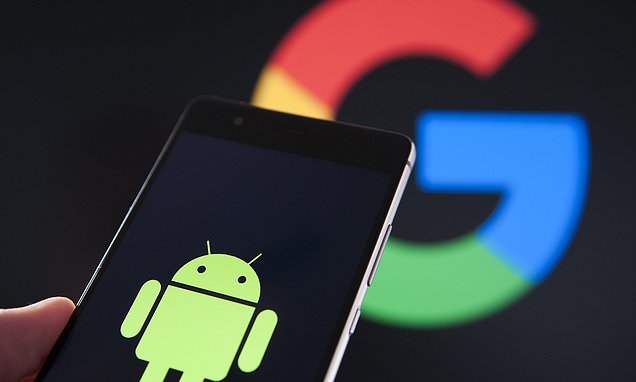Google halts data-sharing program that handed over Android customers’ info to cell carriers over fears that it may attract unwanted attention from regulators
- Google ended a service in April that provided consumer data to wireless carriers
- The program shared location history, usage, diagnostics from Android devices
- Carriers then used that data to expand wireless networks and fill coverage gaps
- Sources say the company was concerned over privacy and regulators’ scrutiny
Google has stopped sharing user cell data with carriers over fears that it could attract unwanted attention from regulators.
According to Reuters, Google discontinued the service which shared user data with carriers, including location history, usage, and diagnostics, in April.
Wireless carriers reportedly used the data to help guide expansions of networks and suss out gaps in their coverage.
Those insights were provided free to carriers and vendors and data came from devices using Google´s Android operating system, which runs on about 75 percent of the world’s smartphones.
Google will discontinue a data-sharing program with cell carriers amid concerns over privacy and how it may look to regulators. File photo
Even though the data was anonymized, and the sharing of it has become commonplace, Google´s move illustrates how concerned the company has become about drawing attention amid a heightened focus on data privacy.
Sources told Reuters that Google shut down the service, called called Mobile Network Insight, due to concerns about data privacy in addition to challenges ensuring data quality.
Google’s Mobile Network Insights service, launched in March 2017, was essentially a map showing carriers signal strengths and connection speeds being delivered in each area.
Data was aggregated, meaning they did not explicitly link any information to any individual phone user and included data relating to a carrier’s own service and competitors, which were not identified by name.
A Google spokeswoman Victoria Keough confirmed the move to Reuters but declined to elaborate, saying only that changing ‘product priorities’ drove the decision.
Google´s notice to carriers when it shut down the service did not specify a reason, two of the four people told Reuters.
‘We worked on a program to help mobile partners improve their networks through aggregated and anonymized performance metrics,’ Keough said.
‘We remain committed to improving network performance across our apps and services for users.’
Google and other tech companies have turned their attention toward privacy as lawmakers further scrutinize how they treat customer data. File photo
The loss of Google´s service is the latest example of tech companies opting to end a data-sharing service rather than risk a breach or further scrutiny from lawmakers.
The European Union´s General Data Protection Regulation, introduced last year, prohibits companies sharing user data with third parties without users´ explicit consent or a legitimate business reason.
U.S. and European lawmakers have stepped up their focus on how tech companies treat user data after a series of large-scale data security failures and the revelation that Facebook improperly shared data on 87 million of its users with political consultancy Cambridge Analytica.
HOW CAN YOU FIND AND DELETE WHERE GOOGLE KNOWS YOU’VE BEEN?
Even if you have ‘Location History’ off, Google often stores your precise location.
Here’s how to delete those markers and some best-effort practices that keep your location as private as possible.
But there’s no panacea, because simply connecting to the internet on any device flags an IP address that can be geographically mapped.
Smartphones also connect to cell towers, so your carrier knows your general location at all times.
To disable tracking on any device
Fire up your browser and go to myactivity.google.com. You’ll need to be logged into Google.
On the upper left drop-down menu, go to ‘Activity Controls.’ Turn off both ‘Web & App Activity’ and ‘Location History.’
That should prevent precise location markers from being stored to your Google account.
Google will warn you that some of its services won’t work as well with these settings off.
In particular, neither the Google Assistant, a digital concierge, nor the Google Home smart speaker will be particularly useful.
On iOS
If you use Google Maps, adjust your location setting to ‘While Using’ the app. This will prevent the app from accessing your location when it’s not active.
Go to Settings Privacy Location Services and from there select Google Maps to make the adjustment.
In the Safari web browser, consider using a search engine other than Google.
Under Settings Safari Search Engine, you can find other options like Bing or DuckDuckGo.
You can turn location off while browsing by going to Settings Privacy Location Services Safari Websites, and turn this to ‘Never.’
This still won’t prevent advertisers from knowing your rough location based on IP address on any website.
You can also turn Location Services off to the device almost completely from Settings Privacy Location Services.
Both Google Maps and Apple Maps will still work, but they won’t know where you are on the map and won’t be able to give you directions.
Emergency responders will still be able to find you if the need arises.
On Android
Under the main settings icon click on ‘Security & location.’ Scroll down to the ‘Privacy’ heading. Tap ‘Location.’ You can toggle it off for the entire device.
Use ‘App-level permissions’ to turn off access to various apps.
Unlike the iPhone, there is no setting for ‘While Using.’
You cannot turn off Google Play services, which supplies your location to other apps if you leave that service on.
Sign in as a ‘guest’ on your Android device by swiping down from top and tapping the downward-facing cursor, then again on the torso icon.
Be aware of which services you sign in on, like Chrome. You can also change search engines even in Chrome.
To delete past location tracking on any device
On the page myactivity.google.com, look for any entry that has a location pin icon beside the word ‘details.’
Clicking on that pops up a window that includes a link that sometimes says ‘From your current location.’
Clicking on it will open Google Maps, which will display where you were at the time.
You can delete it from this popup by clicking on the navigation icon with the three stacked dots and then ‘Delete.’
Some items will be grouped in unexpected places, such as topic names, google.com, Search, or Maps.
You have to delete them item by item. You can wholesale delete all items in date ranges or by service, but will end up taking out more than just location markers.
Source: Read Full Article


